The Great Hokusai - Why do We Still Obsess over that Japanese Wave Painting ?
One of the most immediately recognized artworks, the Japanese wave painting Under The Great Wave off Kanagawa has been shaking up the art world for two centuries and continues to stay in the center of focus of contemporary visual arts and design.
It was created by Hokusai Katsushika, one of the greatest Japanese painters and printmakers of the 19th century, as a part of his series titled 36 famous views of Mount Fuji, a sacred mountain in Japan. The print was initially created by Hokusai around 1830, but the publishing date is 1832. It is created as a woodblock print, using the traditional Japanese ukiyo-e technique.
The work itself speaks a lot about the position of Japan during times of isolation, as well as the influence of Western ideas on the development of a traditional Japanese society and its philosophy. Even though Japan opened its ports for foreign visitors only in 1859, this work contained usage of a distinctive and special European color, the Prussian blue, which means that some kind of cultural exchange existed even during the 1830s. After opening the ports, this work quickly became famous and exported to Europe and America, where it was celebrated by famous artists like Van Gogh, Whistler and Monet. It even influenced Debussy's symphonic sketches titled La Mer.
Besides being popular during Modernism, this artwork still influences many contemporary artists and designers, where it became something like a brand, a work famous for being famous, immediately recognized and celebrated, sometimes possibly without even questioning the reason for it. It also influenced many street artists who paint the walls of the entire planet with this well-known image.
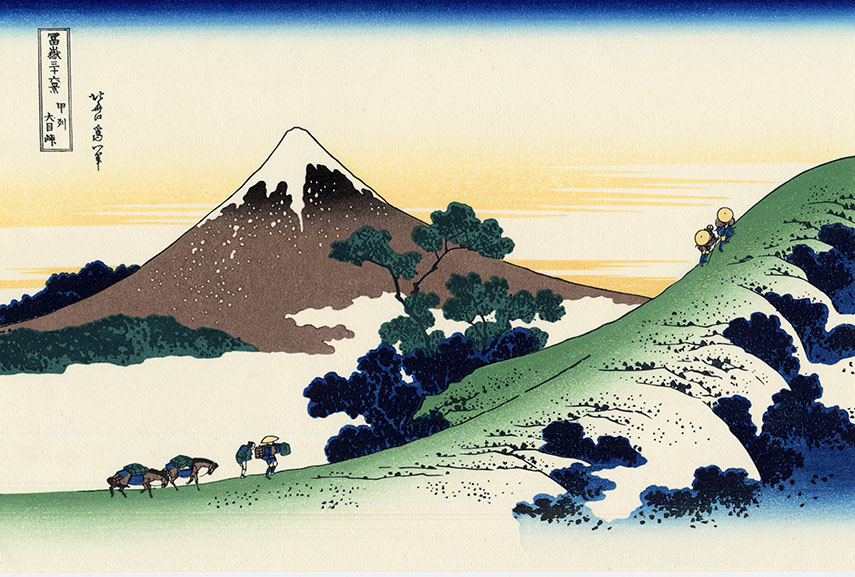
The Japanese Heritage
The woodblock shows an extraordinary skillfulness of the artist in working with the traditional Japanese ukiyo-e woodblock print technique, which requires carving wooden blocks one by one, for each color used. It has to be created precisely and with patience, by carving an image to a woodblock with sharp tools, and then covering the raised areas with ink, while also pressing the block against a sheet of paper.
One of the reasons for the success of The Great Wave in Japan was that it was printed in a new and exotic color, unknown to Japan prior to this work. It had a distinctive saturated hue, it was synthetic and obviously imported from Europe, since we recognize it today as the Prussian or Berlin blue. This opens up new discussions about the way that Japan was connected to the rest of the planet in this moment of history.
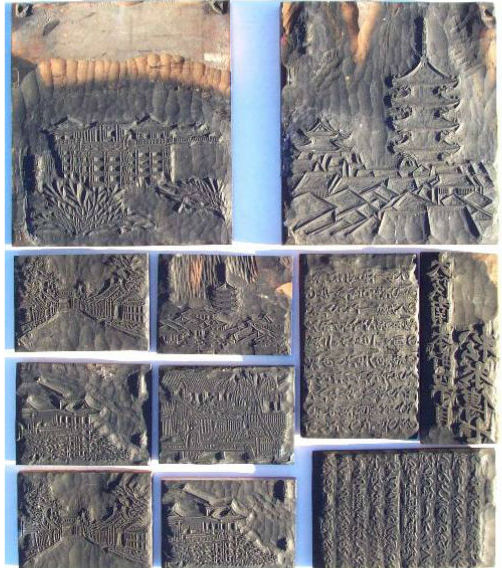
Katsushika Hokusai - A Master of the Edo period
The period Edo period in Japan (1603-1868) is known for its rapid economic growth, strict social order, isolationist foreign policies, a stable population and an overall enjoyment of arts and culture.
One of the most famous and influential artists of this period was Katsushika Hokusai, a famous painter and printmaker, best known as the creator of the woodblock print series Thirty-six Views of Mount Fuji which feature the famous work Under The Great Wave off Kanagawa.
Despite the big waves, which cover the biggest part of the image, the focus is actually on the sacred mountain Fuji, which was a personal spiritual obsession of the artist, but which also serves as an important symbolic representative of the firmness and strength in a stable and isolated Japan, enveloped with its own tradition and culture.
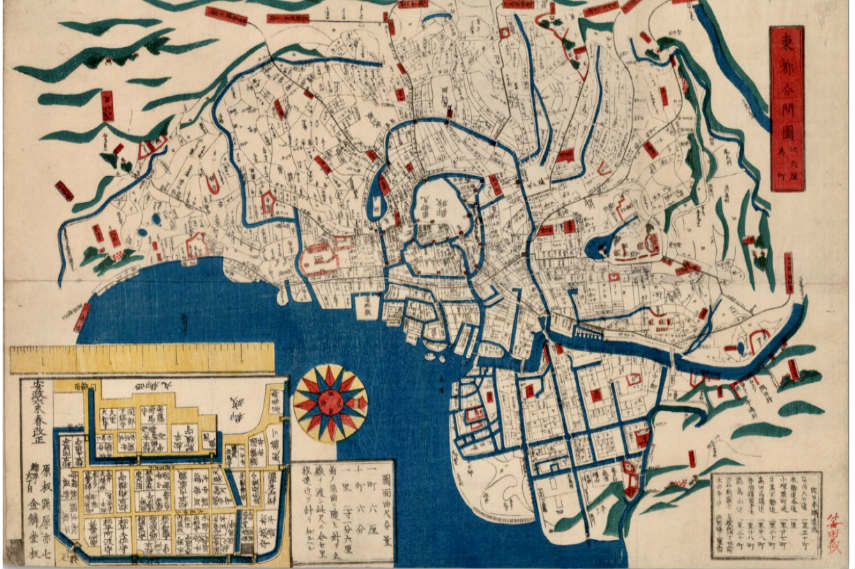
Contextual and Formal Analysis of Under The Great Wave off Kanagawa
The contextual analysis of The Great Wave off Kanagawa could be done on three different levels; the personal one (or what it meant to the artists himself), the socio-historical one (or what it meant for the relationship of Japan with the West) and finally, the philosophical or spiritual one (or what it meant in relation to the sacredness and symbolism of Mount Fuji).
What makes this work unique and omnipresent on the art scene still today could be the presence of all of these three important levels which allow multiple readings, combined with the perfection of composition and usage of color.

Personal Life
Hokusai was over seventy years old when this famous work of his was made, which means he passed a well known symbolic Japanese age of 61 when the person begins their life again and anew.
He believed that nothing he ever created before this age was worthy of notice and that his personal and spiritual attachment to Mt. Fuji was only truly explored by his late series. He actually wanted to devote the rest of his life and work only to this deep honoring of the relationship he has with the mountain.
In the famous BBC documentary about The Great Wave painting, it was stated that his personal life could have influenced the creation of this piece, since Hokusai's grandson gambled away all his money, and he felt great uncertainty in this material aspect of life, which threatened even his spiritual firmness.[1]
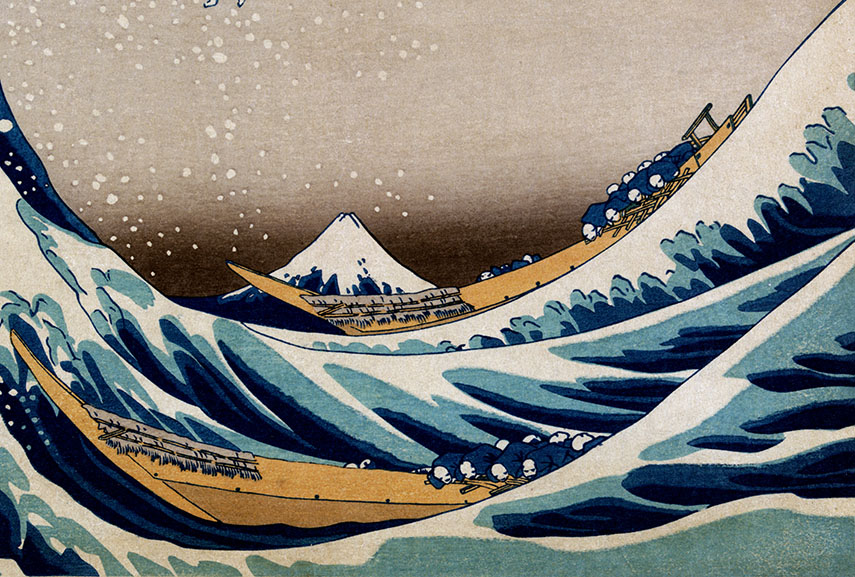
The Socio-Historical Context
The Great Wave can be taken as a symbolic image of an important change happening to the Japanese society, a change which brings the presence of the foreign influences coming from the uncertainty of the sea and opposed to the firmness and stillness of Mount Fuji, the established symbol for the soul of Japan.
The sea had a protective connotation before the end of isolation because it was a barrier that protected Japan from the outside world. However, in The Great Wave painting, the presence of fishing boats going towards the enormous wave represents the parts of Japan that were in contact with the outside, but with a knowledge of uncertainty and the struggles it might bring to the traditional Japan.
But even though the wave looks frightening, the faces of the brave Japanese fisherman in their oshiokuri-bune boats remain calm and decisive in going towards the unknown. The wave starts looking like a mountain, and the mountain in the background looks like a part of the wave, an element which could provide a perspective-changing reading where the sea becomes land and the land becomes the sea.
In this important change, the real mountain and its sacred isolation is not a place where people will prove themselves, the sea is now a new mountain and a challenge with its frightening height, but also with its familiar shape of a mountain.
Could this be a way of Hokusai's reassuring of the Japanese people that their inner strength can deal with new changes and the uncertain future coming ahead?
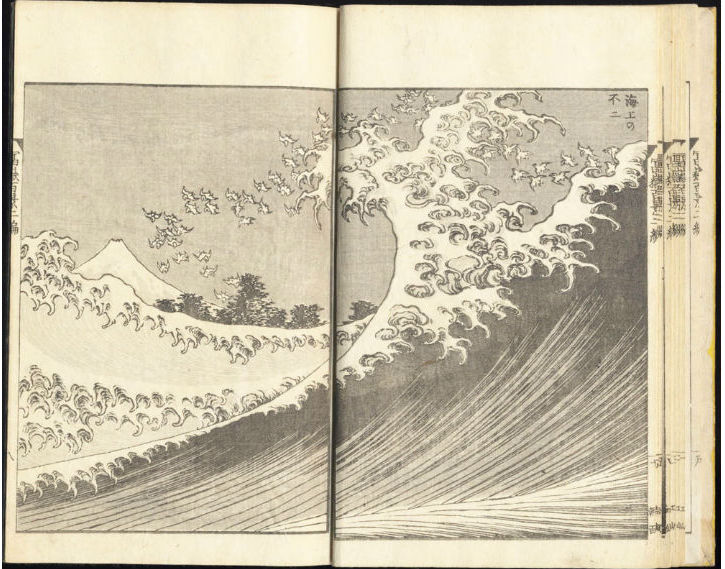
Philosophical and Spiritual Context
The external analyses conducted so far, both the socio-historical one as well as the personal one, were actually deeply rooted in the ancient philosophy and legends about the sacredness of Mount Fuji that were firmly established as a cult in Japan during the time of the production of Great Wave.
For Hokusai himself, as he stated in the colophon to Volume 1 of 100 Views, the highest mountain in Japan is "the source of the secret of immortality." In a folk tale he uses, the entire secret of eternal life was given to this volcano, which continued producing smoke filled with answers till the end of time, therefore remaining alive forever.
This tale influenced his own understanding of the relationship of immortality with his own life, where he states that only when „... I reach one hundred years I will have achieved a divine state in my art, and at one hundred and ten, every dot and every stroke will be as though alive.“
If viewed this way, the relationship between the mountain, the sea, and the people becomes even more complex. The great wave seems like the symbol of the unpredictability of this material form of existence and its mortality, as opposed to the known symbol of eternal immortality and safety provided by Mount Fuji, which now remains in the background and even starts looking like one of the waves.
The wave becomes the mountain, while sacredness should be found even in the ever-changing reality of water, of the sea, in which we are thrown to bravely find a path and reassurance of our own spiritual immortality.
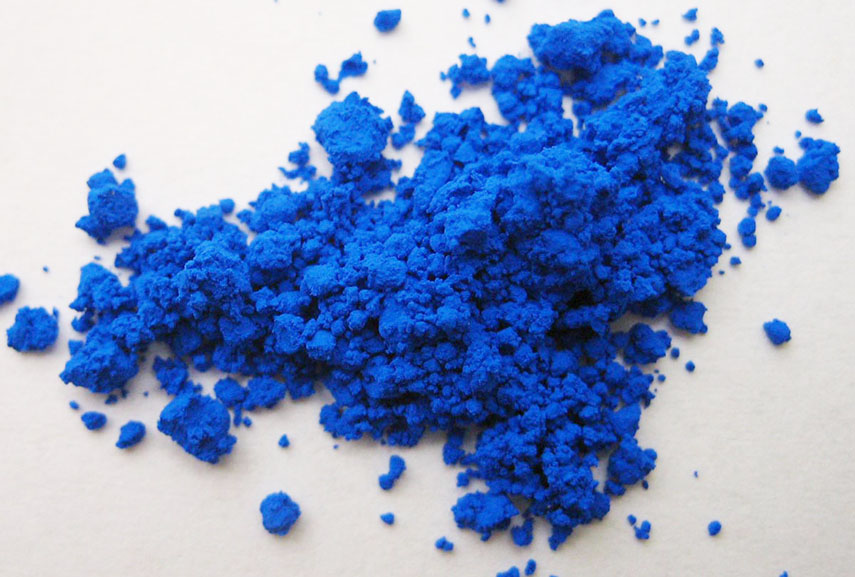
A Formal Analysis - Between East and West
Hokusai was influenced by the work of Shiba Kokan, an artist who was a part of the Rangakusha collective in which artists and scientists devoted their discoveries to the Western principles. These principles could be found primarily in his use of color, as we already stated, but also in the composition of the work which uses the Western principle of reading from left to right, as opposed to the traditional Japanese principle. It also experiments with a low horizon and an element of dynamism through the movement of the wave which takes ups two-thirds of the image.
Hokusai was not an inventor; rather, he was a true translator and an interacting point between the most distinctive styles from both East and West, he made the unknown culture of Japan easily readable to the Western world by using elements of the Western style, but also keeping the important elements of Japanese traditional techniques and motifs. This might have been an important reason for his popularity in the West, which remains even today.

Hokusai - Influence on Western Art
Japonism or the influence of Japanese art on Western culture became most present during the era of Impressionism, by its famous and celebrated artists. The work Under the Great Wave off Kanagawa remains as one of the most reproduced pieces in the last two centuries.
Until WWII, Japanese prints were not published as a limited edition, but the production from only one woodblock went from 8 to 10,000 impressions. They had a low value but still started being present everywhere from the galleries to the streets, so much that now the number of these prints cannot even be exactly counted and it is probably expressed in thousands, or hundreds of thousands.
In the letters to his brother (Letter 676: To Theo van Gogh), Van Gogh states how much he admires the works of Hokusai, praising the quality of his drawing and the great use of line in the famous Great Wave painting. By his words, this work left a terrifying emotional impact on his life and art.
This work also influenced the production of sculptures in the late 19th century, when French sculptor Camille Claudel created La Vague (1897) a sculpture in which the boats from The Great Wave were replaced with sea-nymphs.
One of the best known early artworks inspired by Hokusai surely was the orchestral piece La Mer by Claude Debussy, whose cover for the score's first edition was published by A. Durand & Fils in 1905 and features a reproduction o Hokusai's wave. [2]

Postmodern Representations of The Great Wave Painting
A reference to this work ranges everywhere from contemporary painting, installation, street art to fashion and industrial design.
One of the celebrated paintings which use The Great Wave as a basis is definitely Michael and I are just slipping down the pub for a minute from 1992 by Lin Onus, showing a dog surfing on a creature from the sea, on the top of Hokusai's wave. An interesting digital change has been created on the artwork by the artist Kozyndan, where the foam from the wave was replaced by bunnies in 2003.
It is present everywhere, from the postcards in Japan, to the digital emoji created for Apple OS, t-shirts on the streets of the entire planet, coffee mugs, slippers, walls.

Hokusai in Street Art
Everywhere from London, over Tokyo, to Brooklyn, we can find walls occupied by The Great Wave, showing it both in its original state but also with different meanings, elements, and colors. In the work of the Spanish street artist Pejac on the streets of Tokyo, the work becomes reinterpreted as a tribute to the working women of Japan, where he makes the wave come out of a bucket of a cleaning lady.
The wave becomes red and looks like blood in the mural by the visual artist Lidia Alina, but a similar representation is also made by Probs and Nychos, in London. In Newtown, a huge wall is occupied by the street art collective Big City Freaks who created an enormous 3D depiction of the original Hokusai's wave.
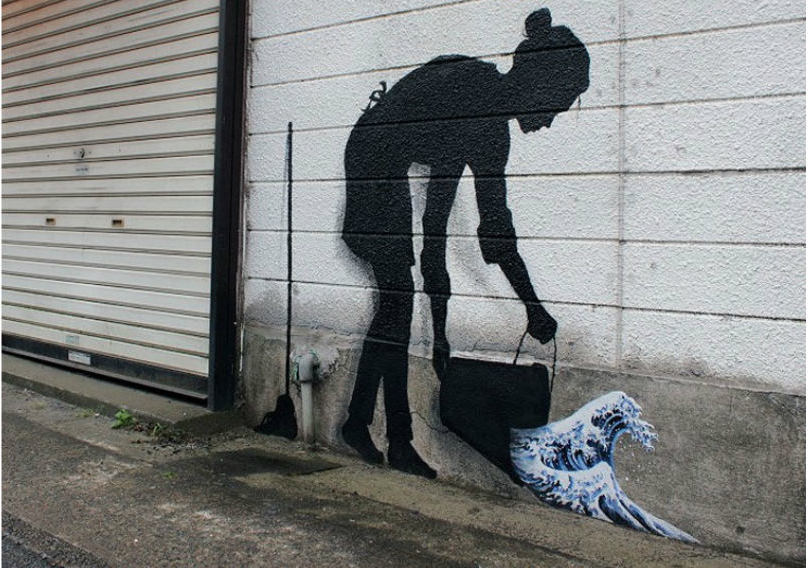
What do we Actually Appreciate it for Today?
After this wide historical examination, and after covering some of the most important contemporary influences coming from this work, we can ask ourselves: what was the final trigger for the popularization of The Wave painting?
The answer is not simple, and the reasons are many. Starting as an ideal introduction to the culture of Japan because of the easily-read image which used Western elements in its style, at a time when Japan was a mystery, the artwork was glorified and recreated because of its freshness and uniqueness.
After the Impressionists, Japonism became very present in Western art, and the whole culture of Japan was glorified as something "exotic".
But maybe there lies an essential problem, since the term "exotic" almost always brings a dose of superficiality with it; superficiality in the form of being obsessed with the mysterious Eastern philosophy, which we do not truly understand and which we view from a strong Eurocentric position.
As time passes, the actual important philosophical deepness in the meaning of this work was lost, and all that was left was its beautiful form and color, which became an eye-catching trigger for fashion designers and artists looking for immediate recognition.
Hokusai's 2021 Auction Record
On March 16, 2021 Katsushika Hokusai’s woodblock print Under the Well of the Great Wave off Kanagawa, made sometime around 1831, sold for the $1.6 million with buyer’s premium - 10 times its low estimate of $150,000! - during Christie’s Asia week sales in New York.
Prints of Hokusai’s wave painting were introduced to the European market in the mid-19th century. Previously, a book of woodblock prints held the record for Hokusai, having sold at Sotheby's in Paris in 2002.
Editors’ Tip: Hokusai's Great Wave: Biography of a Global Icon
Hokusai’s Great Wave, as it is commonly known today, is arguably one of Japan’s most successful exports, its commanding cresting profile instantly recognizable no matter how different its representations in media and style. In this richly illustrated and highly original study, Christine Guth examines the iconic wave from its first publication in 1831 through the remarkable range of its articulations, arguing that it has been a site where the tensions, contradictions, and, especially, the productive creativities of the local and the global have been negotiated and expressed. She follows the wave’s trajectory across geographies, linking its movements with larger political, economic, technological, and sociocultural developments. Adopting a case study approach, Guth explores issues that map its social life across time and place.
References:
- Henry D. Smith, Hokusai: One Hundred Views of Mt. Fuji, George Braziller, Inc., New York, 1988
- Christine M. E. Guth, Hokusai's Great Wave: Biography of a Global Icon, University of Hawaii Press, London, 2015
Featured images: Hokusai Katsushika - Under the Great Wave off Kanagawa, 1832, Captions, via Creative Commons / Alena Akhmadullina - Great Wave Dresses, Courtesy of Rocketstar / Kozyndan - Bunny Wave, 2003, Courtesy of Wikipedia / Lidia Alina - Great Wave Mural, Courtesy of StreetArt Journal / WallMac - Great Wave Stickers for MacBook, Courtesy of WallMac. All images used for illustrative purposes only.
Can We Help?
Have a question or a technical issue? Want to learn more about our services to art dealers? Let us know and you'll hear from us within the next 24 hours.

